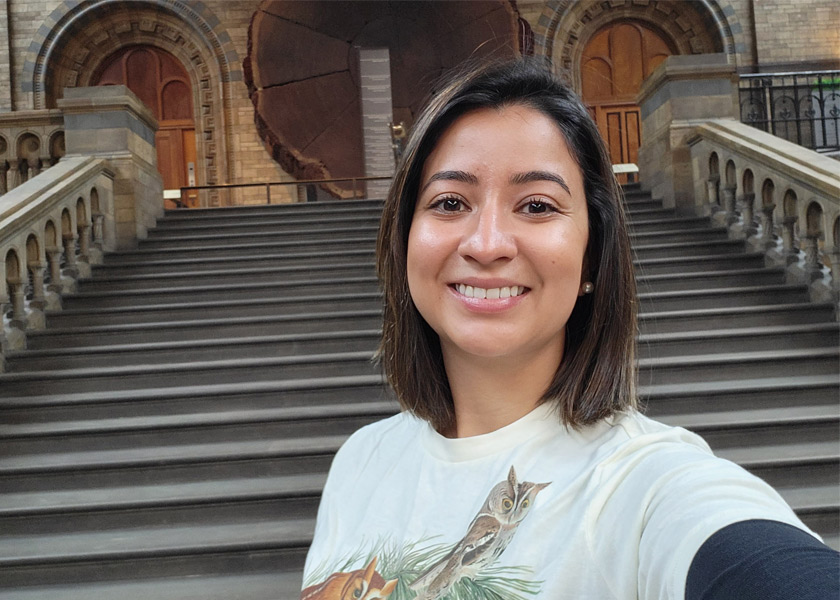In celebration of the Natural History Museum X Joanie collection, we're sitting down with some of the female scientists working at the Museum across an array of fields to learn more about what got them into science and their careers so far!
Can you tell us a bit about your specific area of study or interest?
In a nutshell, I study the interactions between microbes and minerals, an area of research known as geomicrobiology. Microbes are known for promoting the formation of several minerals and also for using different elements within these minerals to fuel their metabolic activities.
My research is focused on the use of rock-eating microbes for the extraction of metals (e.g., copper, nickel, and cobalt) from mine wastes, rock dumps, and contaminated wastewater. These metals are some of the ones we need for the transition to a green economy, and while processing these wastes, we are also minimising environmental and social impacts caused by legacy mining activities.
What has your career looked like so far, and what drew you to the Natural History Museum?
I have always been enthusiastic and fascinated by the natural world, and microbes, despite being invisible to the naked eye, are an integral part of it. During my Ph.D., I had the opportunity to develop a bioprocess for cleaning up contaminated mine waters and disseminate my research findings at several conferences and scientific meetings. When the opportunity to join the Natural History Museum arose, I had no doubt that it would be the best place to be if I wanted to continue working in this area.
As a Centre of Excellence for research, we have the opportunity to develop and share our research ideas with highly renowned scientists across Life and Earth Sciences. Scientists at the NHM have access to cutting-edge technology as well as one of the largest natural world collections in the world!
I'm most enthusiastic about the opportunity to disseminate our research and engage with the general public by participating in several outstanding outreach activities, something I had not done before. It is fantastic to talk to parents and children and explain why we must care for our planet.
What inspired you to get into science - is it something you’ve always been interested in, or was there something or someone specifically that influenced your decision to pursue a career in STEM?
The inspiration to pursue a career as a scientist came from one very special woman - my mother. As a young girl, I always loved going to the University where she worked and waiting for her to finish her activities.
I used to wander up and down the corridors looking through the windows, mesmerised by the set-up of the pharmaceutical laboratories and by the scientists doing actual science right in front of me! I always wondered if one day I could go in there and “play” with those incredible instruments.
When my time to choose a career came, it was only natural that I followed mum’s steps into Academia and ‘eventually take over her post at the University’ – that was her ultimate dream - but I preferred to move away from synthesising and testing new drugs to learn more about microbes and the environment.
What would you say are the major challenges as a woman working in a scientific field?
As for any other field, the main challenge is undoubtedly trying to achieve a healthy work-life balance, particularly when it comes to starting a family. Science never stops - on the contrary, it advances so quickly that it is hard to keep up. Being away for long periods of time (e.g., on parental leave) can hugely impact the career of a scientist in terms of productivity, which often coincides with an early career stage, where short-term contracts are the norm, and the competition is fierce. Also, the return can be incredibly daunting. Juggling both is beyond admirable (and more and more women are making it work!) but it certainly comes with its challenges.
What advice would you give to aspiring young scientists - especially young girls - who might feel daunted by the prospect of scientific study?
Science changes the world! Everything that we have and do – from medicines and vaccines right through to construction and engineering and tech devices - once had to be experimented on in a lab or a testing facility somewhere around the globe. It had to be thoroughly studied by physicians, mathematicians, engineers, biologists, and chemists.
More importantly, we are living a planetary emergency, our planet needs you and me, and we need the help of young minds to make discoveries, improve our quality of life, understand ecosystems, to create a world where both humans and the environment thrive together. Never stop being inquisitive!
What’s the most exciting thing about your job?
There never is a boring day! As a scientist, you get to develop many different skills, you apply your training, you are constantly learning new things, you disseminate your discoveries to other scientists and the general public, you network and make contacts which open new avenues for scientific collaborations, you challenge and get challenged, you convince funding organisations about the importance of their contribution for the development of your field.
Being an environmental scientist at the Natural History Museum takes the excitement to a whole new level! You are surrounded by scientists who work together to learn, improve and protect our natural world.
Shop the Natural History Museum X Joanie collection now, exclusively at Joanie Clothing!








